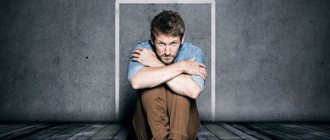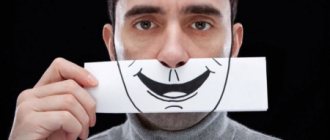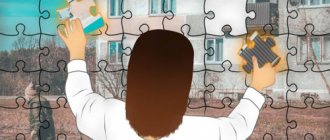Fear, a feeling of discomfort and the desire to run away from a person are nothing more than anthropophobia. Fear takes over when you have to speak on stage or answer in class at the blackboard or in front of an audience at the university. Before going out in public, fear causes your heart to beat loudly, your hands to sweat and tremble, and your legs to become weak. Many people feel a lump in their throat when they are forced to be in a group of other people. Fear of people is one of the forms of social phobia related to neuroses, in the International Directory of Classification of Diseases, listed under the code F 40 - phobic anxiety disorders. American psychiatrist G. Sullivan believed that in order to understand the reason that caused the phobia, it is important to “unravel the tangle” of relationships between a person suffering from fears and other people from his close circle.
What is this disease of fear of people called? Anthropophobia - now you know.
Anthropophobia and social phobia: what are the differences?
Both of these anxiety disorders fall under the same general category: social phobia. Both of them are associated with fear of people, communication with them, or any social activity.
However, there are differences between a fear of people and social phobia. With social phobia, life is much easier for an individual than for an anthropophobe. Experiencing fear of people, the anthropophobe is forced to constantly avoid contact with representatives of any social groups or with all people in general. A sociophobe experiences discomfort when participating in any social activities, when communicating with a team or an unfamiliar company. In his case, eliminating the object of phobia from life is somewhat easier.
Classification
Fear of society
Fear of one's own kind ( anthropophobia , from Greek anthropos - person, phobos - fear) is one of the most severe forms of phobias, because with arachno- or aerophobia it is possible to exclude traumatic factors - spiders and flights, and with anthropophobia it is almost impossible to avoid society around the clock.
Fear of contact with any person makes the patient’s life as uncomfortable as possible. After all, we are all social beings, with our own needs and life tasks, for example, the need for self-development, reproduction, career growth. However, it should not be confused with a state where a person is afraid to perform social actions. If a person is being watched by an imaginary or actual person (group of persons), then this is already social phobia .
Fear of crowds
The fear of large crowds of people is called demophobia . Unlike anthropophobia, the patient does not experience fear when interacting with individuals; panic attacks and stress develop only in crowded places. It is much simpler and easier to cope and live with such a problem; it is enough to avoid large companies.
Fear of men
Social phobia in which males are the object of fear is called androphobia . It occurs more often in women, but there are cases where it was also diagnosed in men.
Like other psychological disorders, androphobia is treatable, but many patients are afraid to admit that they suffer from this problem. The reasons for the fear of men lie in the experience of violence, cruelty, unsuccessful first sexual experiences, and even constant unflattering statements from those around them towards men, watching films with male aggressor protagonists.
In clinical practice, there are other types of anthropophobia; there are cases when patients are afraid of people of a certain profession (for example, most often dentists and other doctors), a certain age, social status (superiors), etc.
Causes and risk factors of anthropophobia
Although there are several assumptions about what anthropophobia is and what the mechanism of its development is, the exact causes are unknown. Most practicing psychologists are inclined to believe that its development is caused by events that take place in childhood or adolescence.
Anthropophobia is a deviation that occurs due to previously suffered:
- ridicule of peers,
- unfavorable family situation,
- resentment towards parents
- regular intimidation or punishment.
Detailed factors increase the likelihood that a child (whose personality is just beginning to form) loses trust in others. If you notice that he prefers privacy, this signal is worth paying attention to. A child, feeling calmer and more confident when alone, may come to the conclusion that the only safe person for him is himself. This is the starting point that leads to the emergence of anthropophobia.
Fear of people most often overtakes individuals:
- with a weak type of nervous system,
- prone to increased levels of anxiety,
- with neuroses,
- having low self-esteem and excessive self-criticism.
People with anthropophobia do not consider themselves part of society, sometimes as inferior or useless members of it. This is an exaggerated reaction of the psyche to a possible repetition of violence, ridicule and aggression from others, which came from parents, classmates or strangers.
Ways to get rid of a phobia
To get rid of a phobia, you need to realize its presence; not everyone can understand for themselves that this happened. Anthropophobia in severe form is treated under medical supervision; self-treatment can aggravate the situation. A progressive phobia can provoke serious mental illnesses. The psychotherapist prescribes medications and conducts conversations.
Treatment begins with analysis and search for the root causes of fear. The first and most important thing that will help overcome a phobia is the patient’s personal interest. In the process of therapy, the anthropophobe relearns how to make contact with people by performing simple actions, such as traveling on public transport, talking on the phone, walking along a crowded street.
At an appointment with a psychologist
In the early stages, you can get rid of a phobia yourself by taking control of your emotions. To get rid of a phobia you need to:
- Accept the fact that you are afraid of people. Do not look for a reason, an excuse, agree that there is a problem;
- Determine the cause of fear: crowd, team, individuals. Decide what scares you more: the number of people or the need to contact them, talk, work. It's better to make a list;
- Look fear in the eyes. It is necessary to do what causes fear - to make contact with society. Actions will certainly cause resistance from the nervous system, so you need to leave your comfort zone gradually. You can start by chatting on social networks with acquaintances or friends, gradually moving on to phone calls. A personal meeting will help to consolidate the result.
At first, meetings may take place in uncrowded places. When you gain confidence, you can attend public events, go to the cinema, theater, cafe. The main task is to start enjoying communication over time. For conversations, you can look for people with similar interests: films, painting, literature.
Schoolchildren and students who are afraid of others can start with small public speaking: make a report, presentation, answer at the board. If communication with peers occurs spontaneously and it is difficult to think through the conversation, you can prepare for the report and perform excellently. Small victories over oneself help to get rid of fear, a person becomes more confident in himself.
The answer is on the board
From birth, a person is in society: family, kindergarten, school, university, work. Not everyone finds it easy to communicate with others; in the modern world, many suffer from anthropophobia – fear of people. Having noticed the first signs of a phobia, you need to take control of your actions, try not to close yourself off, and if necessary, consult a doctor.
Signs of anthropophobia
Anthropophobia is expressed by a specific clinical picture, which involves cognitive and autonomic disorders. Cognitive manifestations include an inexplicable, persistent fear of the thought of speaking, touching a person, going out to people, or meeting a dangerous person. Autonomic symptoms of fear make themselves felt:
- tremor of the limbs;
- attack of suffocation;
- rapid heartbeat;
- numbness;
- redness or pallor of the face, spots on the chest;
- sudden sweating;
- vomiting, diarrhea.
When panic attacks occur in anthropophobes, there is a need for compulsions - obsessive motor acts that have a protective meaning and are of the same type. Often compulsions are associated with cleaning (washing hands, cleaning, wiping surfaces, dishes). Fear of people, as a rule, has a high level of comorbidity, that is, it is combined with other disorders or diseases, such as depression, alcoholism, and drug addiction. Fear of communication is associated with autism.
Symptoms
Fear of strangers when interacting with objects of fear is accompanied by:
- experiencing negative emotions (anxiety, anger, concern for one’s own safety);
- development of severe vegetative reactions ( tremor , vomiting , hyperemia , profuse sweating , involuntary urination and defecation, etc.)
Anthropophobia in a person causes the development of compulsive behavior - actions that are defensive in nature and repeated in similar situations to prevent their development, for example:
- walking from corner to corner;
- muttering and talking to oneself;
- involuntary chaotic body movements;
- repeated hand washing;
- unbridled appetite and, as a result, stress eating.
Features
Fear of people is a form of social phobia. Its peculiarity lies in the fact that in the life of an individual subject to it there is always an object of fear, which is almost impossible to remove or isolate.
Often, a phobia spreads to a specific group of people who have common external or behavioral characteristics:
- fat or thin;
- bald;
- bearded;
- with tattoos;
- sociable or silent;
- any other.
An anthropophobe may be afraid of accidental touching. He avoids looking other people in the eye and tries to look away. Forced communication causes tangible physical discomfort to a person suffering from a fear of people. Information belongs to rewmed website
General information
Have you ever wondered what the fear of people is called?
Back in 1910 Chudinov A.N. used the term anthropophobia . ICD-10 code – F40.1 Social phobias. This is a type of social phobia that causes negative reactions and panic states during communication, contact, the presence in life of such objects of fear as a person or group of people of a certain profession, social status, or regardless of the type of detail, age and other characteristics of individuals.
Stages of anthropophobia
- Easy. The patient at this stage can independently overcome his fear by encountering the person who is the object of his fear. Only a little effort is needed.
- Progressive. Feelings of fear and other negative emotions in a traumatic situation are uncontrollable. For example, a person suffering from a fear of clowns, when faced with a representative of this profession, may experience a feeling of aggression or, on the contrary, tearfulness, his pulse will increase, sweating will increase, and trembling will occur in the limbs or throughout the body.
- Launched. An anthropophobe does not communicate with anyone, even with relatives this happens extremely rarely. Treatment of anthropophobia in this case is only possible by force.
Causes (etiology) of anthropophobia
Most often, anthropophobia begins in adolescence. It affects men and women equally. Experts urge to look for the causes of anthropophobia in childhood. Physical violence, psychological trauma, stress - all this can become an impetus for the development of the disorder. Gradually, the child comes to the conclusion that he is more comfortable alone with himself than with someone - there is no need to expect a trick, you can relax and trust your own “I”. It is becoming increasingly difficult for him to get rid of mistrust and wariness. This behavior leads to social isolation.
It is believed that this disorder occurs in those people whose self-esteem has been low. Frequent criticism and rejection from significant persons gives rise to a feeling of self-doubt. Being close to others, the patient constantly expects a blow, looks for signs of condemnation from other people and finally finds them.
Anthropophobia can develop against the background of scoptophobia, a neurosis that manifests itself against the background of a constant fear of getting into an awkward situation or disgracing oneself. Those suffering from it often perceive features of their appearance or behavior as a reason for ridicule.
Difficult childhood experiences do not always lead to the development of neuroses. They often appear in those who have not found themselves in difficult situations. However, due to personality characteristics, phobic fears, such as anthropophobia, can develop.
Diagnosis of the disease
Diagnosis of anthropophobia is based on the characteristic signs of the condition and is carried out only by a specialist. It must be remembered that the symptoms of anthropophobia may indicate the presence of certain mental illnesses, so a patient with such a pathology needs an in-depth psychiatric examination. Anthropophobia is often observed together with some other types of phobias, for example, scoptophobia (panic fear of disgrace in front of others) and low self-esteem.
Professional treatment
Anthropophobia is treated by a psychotherapist. Not all fears can be overcome on your own. And self-medication will not always be effective. The main thing here is not to be afraid to ask for help.
Treatment of anthropophobia is carried out in several stages:
- The first sessions are aimed at establishing contact with the patient. The doctor will make sure that the patient feels comfortable with him.
- Next comes the search for the cause. With the consent of the patient, hypnosis can be used to find traumatic memories in the subconscious and rethink them, giving them a different emotional coloring. So, what caused the trauma, the panic, will become just an event.
- In addition, work will be carried out to replace negative associations with positive ones. A psychologist will teach you to think differently about contacts with people.
In addition, the psychotherapist will prescribe medications.
Remember! No one will force you to go to a psychiatric clinic or poison you with strong drugs. This is a false stereotype. Treatment with a psychotherapist will not lead to any problems. But it is important to start it at the earliest stages. As soon as you realize that you can't cope.
Treatment of anthropophobia
Anthropophobia requires targeted and long-term therapeutic work. It is very difficult for a person to cope with such a disorder, so the best way out is to consult a specialist. The psychotherapist teaches the patient methods of relieving nervous tension and tells how he can manage his emotions. In the process of group psychotherapy, various life situations are worked through. During such meetings, a person learns to openly express his thoughts and improves communication skills. As a result of psychotherapeutic treatment, the patient becomes ready for contacts in society and gets rid of the destructive defensive model - avoidance behavior.
The fight against anthropophobia begins with a detailed analysis of the causes of its occurrence. The main factor contributing to cure is the patient’s personal interest. If the therapist and the client join forces, relief is possible. During therapy, the patient gradually learns to contact people, starting with the simplest social actions - buying groceries, going to a help desk, traveling on a tram.
Drug treatment consists of prescribing a group of drugs to the patient:
- sedatives (Validol, Novo-passit);
- antidepressants (Hypericin, a drug based on St. John's wort);
- tranquilizers (Afobazol, Phenazepam).
There are contraindications, consultation with a specialist is necessary!
Reasons for the development of the disorder
Like all mental disorders, anthropophobia has a deep history. Psychologists have to investigate for months, extracting from patients childhood memories that caused trauma. The basis for the emergence of anthropophobic disorder is an unstable psyche in childhood. At risk are children who have been teased or offended at home or on the street. These are children who have been subjected to violence and have experienced a divorce from their parents. Any shock could shake the psyche and make it vulnerable.
Then everything depends on the circumstances. Anthropophobia develops when a person repeatedly finds himself in a situation where he feels threatened by others. These are very strict parents whom the child is afraid of, bullying at school, domestic violence.
It becomes more pleasant for a person to be alone with himself. The child can prohibit everyone in the house from entering his room. Solitude becomes a desirable state. The longer it lasts, the harder it is to go out to people later. But it has to be done.
Thus, after the summer holidays, a mature child with similar injuries may experience severe psychosomatic manifestations. He will feel bad before going to school. The pressure may rise, the pulse remains at around 90-100 beats. Doctors will not find anything on the physical level and will prescribe sedatives. But they will only ease the symptoms. Psychologically, it will become increasingly difficult to leave the house and talk to family.
This is how anthropophobia develops. It causes fear of communication, fear of meeting others. A vicious circle: a person is afraid because he is afraid. As soon as the opportunity to live separately appears, anthropophobia becomes a full-fledged phobia: a person completely protects himself from the world. Communicates with others via the Internet and by phone. Orders food. He prefers not to leave the house or live somewhere far from civilization, where there are no crowds on the street.
The less an anthropophobe communicates with people, the more difficult it is for him to make social contacts. It seems to him that he is acting wisely by protecting himself. It's calmer this way. But, in fact, this only makes the situation worse.
Symptoms of anthropophobia
Let's summarize the above.
- Anthropophobes experience discomfort when communicating with people. Even with family.
- They are uncomfortable with touching and talking.
- They feel afraid before leaving the house.
- They try to live separately.
In advanced forms of fear of people, physical symptoms are present. If you have to come into contact with people, this causes:
- panic;
- increased blood pressure;
- increased heart rate;
- nausea;
- dizziness;
- feeling of suffocation;
- arrhythmia;
- fainting.
Panic attacks occur on the eve of going to the clinic or meeting with friends. Loss of interest in surrounding events. Over time, another extreme comes: a person stops leaving the house altogether.
Traditional methods of treatment
A phobia cannot be eliminated with the help of medications, but folk remedies can overcome unpleasant symptoms, cope with increased anxiety, have a calming effect, and improve sleep.
Anthropophobia can be treated with neuroleptics and antipsychotics, these are the rules of the traditional method. They can cause side effects on almost all systems and organs. Traditional treatment has a much gentler effect on the nervous system; the body does not get used to such remedies. In particular, you can drink juice from beets and carrots, infuse mint and lemon balm, juice from fresh motherwort herbs, decoctions from hawthorn berries and aster chamomile.
Treatment with folk remedies
There are several ways to strengthen the nervous system, achieve a sedative effect, and reduce nervousness and anxiety using medicinal plants and vegetable root vegetables:
- eat 200 g of carrots every day or drink a glass of freshly squeezed carrot juice;
- use 1 tbsp. infusion of aster chamomile, hawthorn or valerian 3-4 times a day (1 tablespoon of raw material is enough for a glass of boiling water);
- 1 teaspoon of tincture or ginseng root or leaves steamed in a glass of water (proportion 1:10);
- consume 100 ml of decoction of mint leaves in the morning and evening (1 tbsp mint per 200 ml of boiling water, which must be boiled for 10 minutes);
- 3 times a day, 30 minutes before meals, drink herbal tea with lemon balm leaves or 30-40 drops of motherwort juice .
Psychotherapy for anthropophobia
Successful treatment of the disorder is only possible if medication is taken in parallel with psychological correction and psychotherapy. Psychotherapy for anthropophobia involves several methods depending on the patient’s personal characteristics.
- Psychoanalysis. This is a rather lengthy process, as a result of which you can find the origins of anthropophobia and get rid of the problem forever.
- Cognitive and behavioral therapy is most effective if the person with anthropophobia knows what caused the disorder, and it happened in adulthood.
- Group psychotherapy is also successfully used in this case and can be combined with individual therapy.
A combination of medication and psychotherapy can be quite effective in treating anthropophobia if a person recognizes the irrationality of their fears and wants to get rid of them. Information belongs to rewmed website
Related posts:
- Panic disorder with agoraphobia The onset of a panic attack is often associated with the fear of getting into...
- Constant fear and anxiety in women Almost all people have experienced feelings of anxiety and fear at least once...
- Can temperature change due to stress? The human body reacts to stress in a variety of ways. Many people are interested in maybe...
- Is mental disorder treatable? By mental disorder, experts usually understand a special mental state that interferes with...
Symptoms (clinical picture) of anthropophobia
Many people feel uncomfortable when their personal space is violated. Every person has a comfort zone, penetration into which makes them nervous and worry about their safety. When a person wants to be alone, but is unable to be alone with himself, a deterioration in mood and even health may occur. These features are normal, but sometimes they can indicate developing anthropophobia.
The main symptom of anthropophobia is compulsive behavior. It consists of performing obsessive actions or movements. The purpose of this behavior is to protect oneself from phobias and block inappropriate manifestations of fear. An example of compulsion is incessant counting in a stressful situation. For example, a person, finding himself in a crowd, without stopping, counts passers-by.
This disease entails the occurrence of many unpleasant conditions. Various neuroses, mental disorders, and depression accompany the already difficult life of a patient with anthropophobia. He is afraid that a stranger will attack him or infect him with an incurable disease. The feeling of loss of health during social contacts is another of the main symptoms of anthropophobia.
His contacts are as limited as possible. He seeks to nullify communication even with the closest people. An anthropophobe will not ask for help and will most likely reject it if absolutely necessary.
It is not easy for someone suffering from such a phobia to find a job, because most professions involve communication. And any training requires communication, which is impossible, because the fear of people is stronger than the desire to work.
Diagnostics
The diagnosis can be easily made by a qualified doctor
The diagnosis is made by a psychotherapist after a conversation with the patient. In addition to diagnosing anthropophobia, the doctor must exclude the presence of other mental disorders in the patient. After analyzing the characteristics of the manifestation of phobia in a particular patient, the doctor draws up a treatment regimen.
An initial consultation will cost 500-1000 rubles. Further treatment depends on the number of sessions and the chosen therapy regimen.
Diagnosis of fear of people
Fear of people develops in 3 stages:
- A person experiences excitement and anxiety when he needs to visit a public place or meet a large number of people. The man pulls himself together and calms down.
- The individual experiences anxiety before meeting new people. He may have a panic attack, he may react aggressively, he tries to push people away (protects himself from new acquaintances).
- The person refuses contacts and withdraws into the walls of the house. At this stage, he cannot control his condition and needs help.
There are no special tests to detect anthropophobia. The main diagnostic method is a conversation with a psychologist. During the diagnostic process, the psychotherapist not only evaluates symptoms according to these stages, but also identifies a characteristic triad (fear of people, avoidance of contacts, somatic manifestations of anxiety). He also interviews the client’s immediate circle. The psychologist assesses the intensity of symptoms and the client’s general condition.
Fear of communicating with people
Despite the fact that every person, from childhood, has to make contacts in society, some of them experience significant discomfort in the process of dialogue. Fear of communicating with people can have varying degrees of severity.
Some may experience slight difficulties at times when interacting in society. Others are afraid of dialogue in public to such an extent that it results in severe mental disorders. This is nothing more than social phobia. In such a situation, a person is not able to get rid of the irrational fear of communication, and in order to cure this phobia, the intervention of a competent specialist is necessary.
Whatever the intensity and regularity of a person’s fear of communication, it is quite possible to overcome such an unpleasant phenomenon.
Pseudohypostasophobia
There are often cases when experts disagree about the reasons for the origin of any of the phobias. At the moment, scientists have no doubt about why and how pseudohypostasophobia arises, and there is already evidence that it begins its development in childhood, under the influence of some incident or a certain situation, with the participation of someone in a mask who frightened the child by their inappropriate behavior. Maybe this happened by chance at a time when no one could have thought that the baby would react negatively to the cheerful (as adults think) holiday mask. But there are cases when such a situation is planned in advance, when the presence of strong and unexpected fear is caused by a frightening rubber mask. It could be a gorilla, or a fantastic creature, especially since modern masks have a completely realistic look, and they can be associated with characters in famous horror films.
The main feature of this outfit is that if a person understands that this is just a performance, then he still has an unpleasant feeling of fear. A similar reaction is characteristic of people who have a weak psyche and a wonderful imagination. But, be that as it may, according to psychologists, such entertainment has a negative impact on children. Among this category of patients, there are also those who develop a feeling of fear at the sight of masks alone, even if people are not wearing them. During a conversation with a psychotherapist, some patients express the belief that the mask is waiting for the right moment when they are sleeping in order to take over their thoughts and minds, and even take over their lives.
Symptoms of anthropophobia
Fear of society and people is manifested by compulsive behavior. When meeting a stranger, an anthropophobe feels insecure and often displays inappropriate behavior. A person can make some meaningless movements, which he regards as protection from strangers. Examples of compulsive behavior are counting passing cars, searching for objects of a certain color, special changes in gait. Such actions help to distract from the people around you and block manifestations of fear.
If for some reason the anthropophobe cannot be distracted, a panic attack begins. It is manifested by increased blood pressure and increased pulse rate, hand tremors, and increased sweating. Being in a stressful situation, an anthropophobe wants to quickly run away and hide.
Such people experience serious problems with others. Their social circle is usually limited to just a few people, most often these are relatives or friends with whom the anthropophobe has known since childhood. Due to fear of people, there is a deterioration in cognitive abilities, which negatively affects the development of new skills and work activity. As a rule, such people are employed in low-skilled jobs, which involve a complete lack of contact with others, or work from home.
In severe forms, anthropophobia leads to complete social maladjustment. A person may not leave the house for months, which further aggravates the problem. Voluntary retreat is becoming accessible thanks to food delivery services, online supermarkets and other benefits of our time.
Forms of social phobias
Social phobia can be isolated or generalized.
Isolated forms of social phobia
These are so-called monophobias - this is the fear that in the presence of other people an individual will not be able to perform even the actions he is accustomed to. This fear is caused by severe anxiety of failure (expectation neurosis). Therefore, a person with monophobia avoids certain life circumstances in order to avoid getting into a traumatic situation for him. Otherwise, he leads a normal life.
It should be noted that in the absence of other people, a patient with monophobia does not have any problems. An isolated form of social phobia is accompanied by minor restrictions in professional or social activities.
Isolated phobias can manifest themselves in different ways. For example, some individuals are afraid to travel on public transport because they believe that other passengers pay attention to them and ridicule them. Others cannot eat in a cafe or at a party, confident that they will certainly knock over drinks or drop dishes and cause laughter and ridicule from staff or visitors.
One of the varieties of social phobia is ereytophobia - the fear of blushing, mixing in society, or causing some kind of awkwardness.
Generalized social phobias
In addition to the fear of getting into a certain situation, a patient with generalized social phobia is overcome by ideas of low value and sensitive ideas of relationship. He is afraid of being ridiculed, afraid that he will seem defective to others. This phenomenon is called scoptophobia (from the Greek word “scopto” - joke, mock).
The affect of shame comes to the fore, which largely determines the patient’s behavior, although in the vast majority of cases it is not true.











